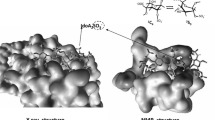Summary
[125I]-Labeled thrombin was incubated with human plasma and its interactions with the two plasma protease inhibitors antithrombin III (AT-III) or heparin cofactor II (HC-II) were investigated in the presence of oat spelts xylan sulfate (OSXS), sodium pentosan polysulfate (SP-54), and the results were compared with heparin and dermatan sulfate. Addition of OSXS or SP-54 enhanced the complexation of thrombin with HC-II or with both AT-III and HC-II depending upon the concentration and the duration of the interactions of the sulfated compounds with plasma. During the 30 s interaction, OSXS and SP-54 enhanced both AT-III-thrombin and HC-II-thrombin interaction while heparin was more selective and enhanced only the AT-III-thrombin interaction. However after a 2 min interaction, heparin showed an increase in the HC-II-thrombin interaction at higher concentrations. The complexations of AT-III-thrombin and HC-II-thrombin were reversed in the presence of 200 μg/ml of SP-54 during a 30 s interaction or in presence of 100 μg/ml of OSXS during a 2 min interaction. The Western blotting method of detecting thrombin showed that during the 10 s interaction, heparin enhanced the thrombin-AT-III complex formation while OSXS enhanced the thrombin-HC-II complex formation.
Similar content being viewed by others
References
Rosenberg R.D., Damus P. (1973): The purification and mechanism of action of human antithrombin-heparin cofactor. J. Biol. Chem., 248, 6490–6505.
Tollefsen D., Blank M.K. (1981): Detection of a new heparin dependent inhibitor of thrombin in human plasma. J. Clin. Invest., 68, 589–596.
Murano G., Williams L., Miller-Anderson M., Aronson D., King C. (1980): Some properties of antithrombin III and it’s concentration in human plasma. Thromb. Res., 18, 259.
Tollefsen D.M., Pestka C.A. (1985): Heparin cofactor II activity in patients with disseminate intravascular coagulation and hepatic failure. Blood, 66, 769–774.
Tollefsen D.M., Pestka C., Monafo W.J. (1983): Activation of heparin cofactor II by dernatan sulfate. J. Biol. Chem., 258, 6713–6716.
Doctor V.M., Sauls V. (1983): Isolation and anticoagulant properties of a new sulfated xylan: comparison with heparin and a sodium pentosan polysulfate (SP-54): Thromb. Res., 30, 573–578.
Tollefsen D.W., Fewgler J.R., Majerus P.W. (1974): The binding of thrombin to the surface of human platelets. J. Biol. Chem., 249, 2646–2651.
Laemmeli U.K. (1970): Cleavage of structural proteins during the assembly of the head of bacteriophage T4. Nature, 227, 680–685.
Lam L.H., Silbert J.E., Rosenberg R.D. (1976): The separation of active and inactive forms of heparin. Biochem. Biophys. Res. Commun., 69, 570–577.
Hook M., Bjork I., Hopwood J., Lindahl V. (1976): Anticoagulant activity of heparin, separation of high-activity and low-activity heparin species by affinity chromatography on immobilized antithrombin. FEBS Lett., 66, 90–93.
Tollefsen D.M., Majerus D.W., Blank M. (1982): Heparin cofactor II: purification and properties of a heparin-dependent inhibitor of thrombin in human plasma. J. Biol. Chem., 257, 2162–2169.
Doctor V.M., Lewis D., Coleman M., Kemp M.T., Marbley E., Sauls V. (1991): Anticoagulant properties of semisynthetic polysaccharide sulfates. Thromb. Res., 64, 413–425.
Shoen P., Wielders S., Petitou M., Lindhout T. (1990): The effect of sulfation on the anticoagulant and antithrombin-III-binding properties of a heparin fraction with low affinity for antithrombin III. Thromb. Res., 57, 415–423.
Campbell A., Nesheim M.E., Doctor V.M. (1987): Mechanism of potentiation of antithrombin-III (AT-III) inhibition by sulfated xylans. Thromb. Res., 47, 341–352.
Carson L., Doctor V.M. (1990): Mechanism of potentiation of antithrombin III and heparin cofactor II inhibition by sulfated xylans. Thromb. Res., 58, 367–381.
Sun X.J., Chang J.Y. (1989): The heparin and pentosan polysulfate binding sites of human antithrombin overlap but are not identical. Eur. J. Biochem., 185, 225–230.
Tanyi A., Benjamin V., Sadberry A.J., Doctor V.M. (1994): Fluorescence and circular dichroism studies during the interactions of sulfated polysaccharides with antithrombin III. Unpublished observations.
Author information
Authors and Affiliations
Additional information
An erratum to this article is available at http://dx.doi.org/10.1007/BF03226371.
Rights and permissions
About this article
Cite this article
Simmons, R.B., Newton, G.R. & Doctor, V.M. Effect of sulfated xylans during the interaction of [125I]-thrombin with antithrombin III or heparin cofactor II of human plasma. Eur. J. Drug Metab. Pharmacokinet. 20, 73–77 (1995). https://doi.org/10.1007/BF03192291
Received:
Issue Date:
DOI: https://doi.org/10.1007/BF03192291



